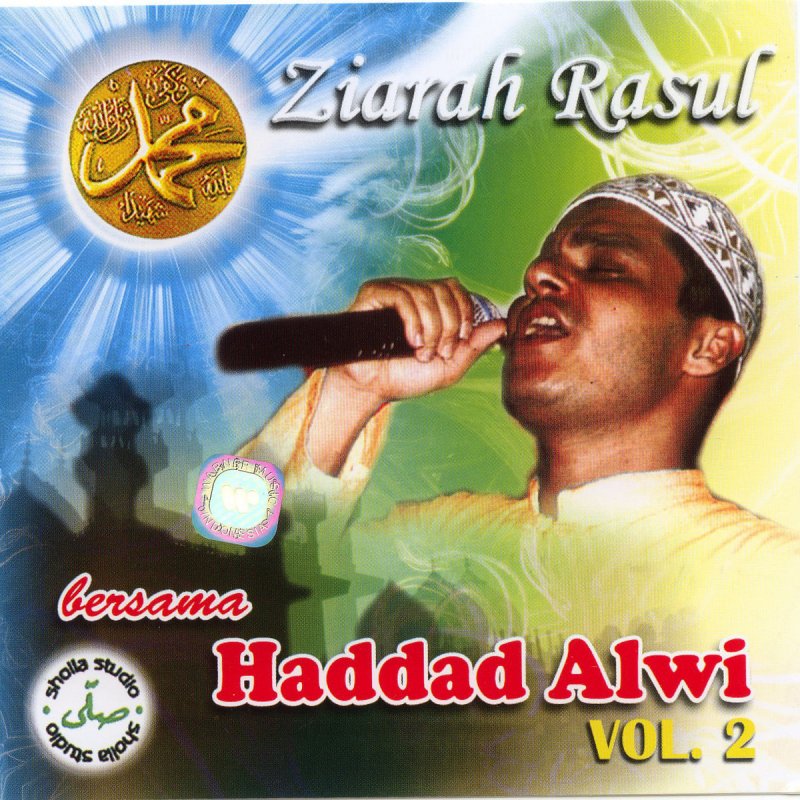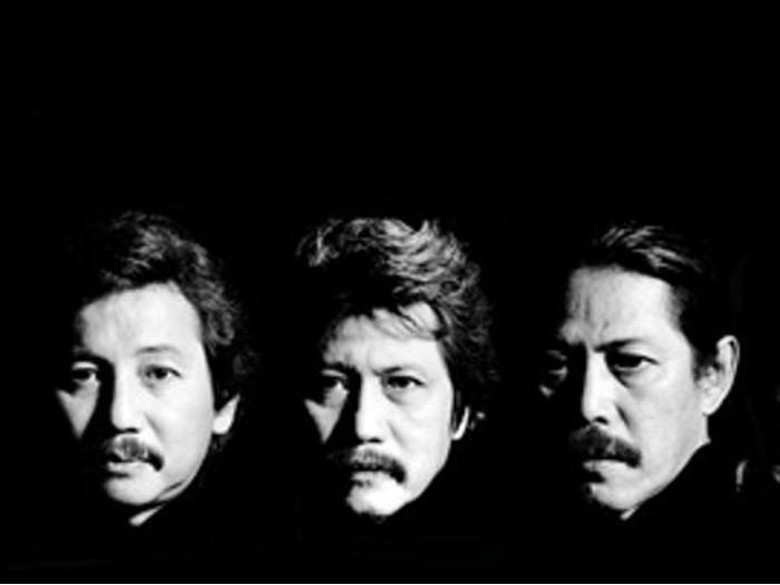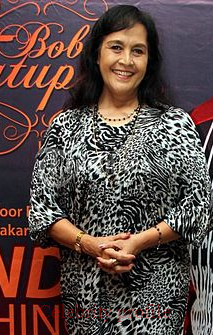Live Streaming
Program Highlight
Company Profile

Music (61)
May
 We will present various Indonesian religious songs by Chrisye and Haddad Alwi. The song “Ketika Kaki dan Tangan Berkata” was composed by an Indonesian writer Taufiq Ismail reminded all of us that in the hereafter, human must be responsible for all charity deeds. The song "Ketika Kaki Dan Tangan Berkata" also ends with an appeal to GOD to stay permanently on the right way of life. The next song entitled "Damai Bersamamu" by Chrisye. The song "Damai Bersamamu" was released in 1996. The song "Damai Bersamamu" tells about expression of gratitude to GOD Almighty.
We will present various Indonesian religious songs by Chrisye and Haddad Alwi. The song “Ketika Kaki dan Tangan Berkata” was composed by an Indonesian writer Taufiq Ismail reminded all of us that in the hereafter, human must be responsible for all charity deeds. The song "Ketika Kaki Dan Tangan Berkata" also ends with an appeal to GOD to stay permanently on the right way of life. The next song entitled "Damai Bersamamu" by Chrisye. The song "Damai Bersamamu" was released in 1996. The song "Damai Bersamamu" tells about expression of gratitude to GOD Almighty.
 T
T
he next religious singer we will present to you is Haddad Alwi. He was born in Surakarta, on March 13, 1966. Hadad Alwi has the best-selling religious album in the history of Indonesian music. He started his musical career from the concern about the lack of a religious theme song. So, no wonder if Haddad Alwi has released a variety of religious songs for children in a duet with some little artists.
Haddad Alwi's career began in 1997 with two shalawat albums "Nur Muhammad" and "Ziarah Rasul". Then from 1999 to 2004, Haddad Alwi collaborated with Sulis to produce an album entitled "Cinta Rasul" volume 1 to 6. "Cinta Rasul" album also called as the best-selling religious album in Indonesia.
May

Welcome to the Rhythm of the Indonesian Archipelago!
In today’s edition, we will invite you to visit Banten namely Pandeglang. Actually, this region is not far from Jakarta. The province was part of West Java province but it has been expanded since 2000 based on the law No. 23/2000. Its central government is in Serang. The region has traditions which are still preserved by people and supported by Banten Tourism Office. One of the traditions which is still preserved by Pandeglang people is Rampak Bedug.
Almost in all mosques, Bedug is found and used by local people as media to remind obligatory prayers’ time. The word of “Rampak” means “Serempak” or in English means ‘Simultaneous’. So, “Rampak Bedug” is bedug art by using Waditra, namely “many” bedugs and beaten simultaneously and it produces beautiful typical rhythm. Rampak Bedug only exists in Banten as characteristic of Banten’s culture. Rampak Bedug” is development of bedug art or Ngadulag. Ngabedug can be played by someone professional. The Head of Tourism Agency of Banten on 2016 DR. Moh. Ali Fadilah explain history of Banten kingdom.
“…Long before the establishment of Banten Sultanate, there was Sundanese kingdom which was not different from its tradition, and language with West Java. When the sultanate entered to Banten region, there was cultural assimilation between Javanese and Sundanese cultures. Thus, Banten has many sources which can be found from local tradition. It can be seen from its art, and its north beach. Take, for example, many arts are in Islamic nuance; South Banten has more traditions related to religious rituals, especially to commemorate or just express gratitude to the God on its abundant harvest.” He said.
Rampak Bedug was performed for the first time in 1950s. At that time, in Pandeglang district, competition was held among hamlets. Then, in 1960-1970, Haji Ilen created creative dance in Rampak Bedug which has developed today. Then, Rampak Bedug is again developed by Burhata, Juju, and Rahmat. Therefore, Haji Ilen and his friends are the figures of Rampak Bedug art. From those artists, Rampak Bedug art spread to other regions. Until the end of 2002, there were many Rampak Bedug groups. For the first time, Rampak Bedug was to welcome the holy month of Ramadhan and Idul Fitri. Its performance is like Ngabedug or Ngadulag. Meanwhile, Banten Culturist, Rohaendi give brief information about how the tradition begins.
“…At the beginning, to compete bedug was to show masculinity of a hamlet where young men or residents of the hamlet had power. More bedugs which are owned showed that the hamlet had a man who was stronger. When Idul Fitri or when Ramadan came, there was a tradition where residents conducted bedug nganjor. Nganjor was to move. Certainly, its bedug was not as big as bedug which was beaten when there was a competition. Because the then nganjor was mobile and its bedug was smaller to carry around alleyway. Those people who carried it shouted one another and then, they met in one place to play together.” He said.
Bedug itself is one of percussion instruments. Interestingly, the typical bedug of Banten is not made from wood like other bedugs in Indonesia. Bedug from Banten is made from coconut trunk which is perforated on the middle. Then, one side is covered by using cow leather and tied with disc earring made from guava tree. Rampak Bedug is genial art and can attract the audiences, so that Rampak Bedug is worth selling, similar with other commercial musical arts. Although the originators and players are based on religious motivation, Rampak Bedug artists and creators view it as a valuable work of art.
“…According to the people in Pandeglang, Bedug is a tradition which becomes power and symbol of masculinity. Then, it develops as other traditions and it follows the changing times, which originally came from music only. When there is requirement for performance, technical elements of the performance are combined with the art. There are choreography, fashion arrangement, stage arrangement and many others. Now, people call it as Rampak Bedug. Actually, it is not only music but also dance, fine art, theater in it .” Rohaendi continue.
Religious, economic and creative values make Banten people be able to preserve Rampak Bedug. The functions of the values make Rampak Bedug survive from the influence of foreign culture which is loved by young generation. Rampak Bedug is not only an art for Banten people but also a tradition.
“…A tradition will survive if people need it. It is impossible, if people want to preserve it without surviving it. And Karang Tanjung, belonging to Kembang Tanjung studio proves that they do not only talk but also do it. What the elder did with various creations and packages still survives and this is loved by young people.” He added.
Creative art will develop rapidly. Rampak Bedug is getting richer and richer with creativity without eliminating values which have been determined in the art. Diversity and togetherness exist clearly in Rampak Bedug.
May

Welcome back to Music Corner, a musical segment which introduces you to Indonesian music, either traditional or modern one. In today’s edition, we will present the songs from North Sulawesi.
Although the rhythm of the song sounded cheerfully, the pop song from North Sulawesi region is about a broken heart. Listener, this song is accompanied by modern music and nuances of traditional music of North Sulawesi.
Like the previous song, the song di Pantai Ene Mawita also combines with pop music and traditional music of North Sulawesi. The beach becomes a place that is often visited by people when unwind or just enjoy the beauty. This song tells the story of someone sitting on a beach in North Sulawesi, ENE MAWIRA beach, just to reflect and remove the sadness. The beach is usually more suitable for people who are reflecting, the only sound of the waves breaking on the beach.
May

Welcome back to Music Corner, a musical segment which introduces you to Indonesian music, either traditional or modern one. In today’s edition, we present some religious nostalgic songs from the Indonesian music group, Bimbo. Trio Los Bimbos was the forerunner of Bimbo group formed in 1967. Its personnel consists of 3 brothers Sam, Acil, and Jaka. In the mid-1970s, Trio Los Bimbos was later changed into Bimbo by adding a personnel, Iin Parlina, their younger sister. Along with Iin Parlina, the group began to compose the songs which describe about daily life themes, such as "Abang Becak". Entering the era of the 1980s, Bimbo began to make songs of social criticism and religious songs. Their first religious song entitled "Tuhan".
The lyrics of this song were made by a famous Indonesian poet, Taufiq Ismail. The lyrics are simple but have a deep meaning wrapped with a touch of music from Sam and the characteristics vocal of Bimbo, make it becomes a legendary song and very famous among people especially the music lovers. Until now, the song is still often played, especially during the holy month of Ramadhan. This song tells about the greatness of God as a substance of the Almighty. If we come closer to GOD, then GOD certainly will be close to us.
May
We will present you some regional songs. Some of these Komering lyrics are in the form of rhymes. The lyrics describe someone who is seducing the idol of the heart. The song "Ombay Akas" is usually sung alone or duet. The next song from South Sumatra that we will present to you is "Cuk Mak Ilang". The song "Cuk Mak Ilang" has many versions. However, the main theme that is presented in the lyrics is the love of young people, such as the broken heart due to the trapped boyfriend, meeting the idol of the heart, and the sense of longing. In its various versions, the song "Cuk Mak Ilang" contains poem which can become longer if more and more people sing the song. Many songs from South Sumatera are indeed with happy nuance. However, without doubt, there are some other songs that are deep, such as "Jengan Harak" and "Dirut". The song "Jengan Harak" which literally means "Do not Divorce" contains messages for young people, especially the newly married. The message of the song is that when celebrating marriage, it does not need to be too extravagant. Then, for only one-month marriage, the couples are in quarrel. Meanwhile, the song "Dirut" is not an acronym for "President Director". The Dirut is the name of a kid who is left by his father to go wandering. The Dirut is longing for his father, but his father will never come home again. Because, the father passed away somewhere he went .
May

We will present Indonesian popular song by Mulan Jameela. A song entitled Wonder Woman, sung by Mulan Jameela was taken from the name of the superhero comic character contains the outpouring of a woman who has long been hurt by her lover. The song "Wonder Woman" is one of Mulan Jameela's famous songs. Mulan Jameela was born in Garut, on August 23, 1979 with the name Raden Terry Tantri Wulansari. Throughout her music career, Mulan has repeatedly changed her stage name such as "Wulan Ardina" in 1999 when she run a soloist career and later changed to "Mulan Kwok" when she joined with Maia Estianty as Ratu in early 2000s. In 2007, Mulan seperated with Ratu and renamed her stage name as "Mulan Jameela". Mulan Jameela joined the artist management led by Ahmad Dhani, an Indonesian famous musician. Mulan Jameela also launched several works, such as her first solo album entitled "Mulan Jameela" in 2008. After that, Mulan Jameela released her album "99, Vol 1" in 2014 and "99 Volume 2" Patience "in 2018. Mulan Jameela included a singer who has a distinctive and strong voice. So that, Mulan can easily welcomed by Indonesian music lovers. However, Mulan does not only play her career in pop and rock genres. Because at the beginning of March 2018, Indonesia’s netizen were surprised by a video featuring Mulan to sing dangdut songs. It shows that Mulan Jameela always explore her talent in another musical genre.
May

We will present songs from the East Java region. The song sung by Umar Dhani is unknown who composed it. This song tells about the tradition that is commonly done by Madura community, namely “Kerraben Sape”. Sape or Karapan Sapi or cow racing is a term for the cow racing that originally comes from Madura, East Java. In ancient times, many tourists came to Madura Island to witness the Karapan Sapi which is held annually. In this race, each cow that is contested is ridden by a small jockey to quickly reach the finish line. Another East Java song entitled "Tanduk Majeng" is also the one from Madura people. Tanduk Majeng means the pleasure of fishing. This song tells about the life of Madura people who live as fishermen. Life as a fisherman is very hard because every time, there is always anxiety about danger at sea. Although being dangerous and threatening, Madura fishermen still go to catch fish at sea for their family’s life.
May

We will present some popular songs from Vidi Aldiano. The song "Tak Sejalan" was the latest single released by Vidi Aldiano in early April 2018. The song tells the story about the man who wish to be in love with the beloved girl. However, he is dissapointed because the girl has already choose another one. "Tak Sejalan" is one of the songs made by Vidi Aldiano when he was on vacation in the United States. The song "Tak Sejalan" was taken from the experience of watching a musical performance in Broadway which, according to Vidi Aldiano managed to touch the audience. So, Vidi wanted to make similar music through the song "Tak Sejalan". The song entitled Definisi Bahagia was inspired by the people closest to Vidi Aldiano such as friends, family, and producers. The song "Definisi Bahagia" by Vidi Aldiano was released in two versions. The first version is cheerful and full of dynamic nuances. While, the second version re-arranged with Andi Rianto has solemn nuance. In the Indonesian entertainment industry, Vidi Aldiano has undergone various changes, both in terms of music and appearance. Not only play in front of the screen as a singer and actor, Vidi Aldiano was also ventured to be a music producer. Through his record label VA Records, Vidi Aldiano wants to realize his dream of becoming a businessman. However, Vidi will not stop entertaining especially his fans and the whole Indonesian music lovers.
May

Welcome back to Music Corner, a musical segment which introduces you to Indonesian music, either traditional or modern one. In today’s edition, we present the songs from South Kalimantan Province.
Every region in Indonesia has their own regional songs. Some of the songs are already popular in Indonesia, such as Ampar-Ampar Pisang from South Kalimantan. The Banjar song was composed by Hamiedan AC. This song is usually sung by children in the game. Ampar Ampar Pisang can be defined as spread bananas before drying. In ancient times, banana was one of the main foods in Banjar Kingdom. Bananas are usually processed into various foods, but previously the bananas are dried first. That’s a glance about the story of the song Ampar-Ampar Pisang.
This song is quite easy to remember with a carefree rhythm. Despite having simple lyrics, this song has deep meaning and full of moral messages. In Indonesia, Saputangan Babuncu Ampat means Four Handed Sweep Handkerchief.
In the society, human relationships are always adorned with conflict. However, the conflict often causes pain. As in the lyrics "Luka nang di tangan kawa di babat, luka nang di hati hancur sakali” means Wound on the hands can be bandaged, but the wound in the heart is difficult to cure. The song also has a positive massage to forgive each other. The song ‘Saputangan Babuncu Ampat’ has lyrics of old poems or pantun. Like most old poem, it is often made to convey certain messages.
May

We present Keroncong songs by Tuti Maryati. The singer who was born in Makassar, South Sulawesi on October 8, 1956, also known as Tuti Tri Sedya. The song entitled “RAYUAN PULAU KELAPA” composed by Ismail Marzuki tells about the beauty of Indonesia. The islands with coconut trees become an idol of the people all the time. This song is one of the national heroic songs of Indonesia.Tuti Tri Sedya spent her teenage years in Bandung, West Java. After that she continued his education to ASMI Jakarta, then continued her study at the Faculty of Law UPN Veteran University, Jakarta. During her education, Tuti achieved a number of achievements. In 1975, she was elected in the 'Indonesia-Canada World Youth Exchange Program'. In her singing career, Tuti’s name began to be known since she won the first title of Radio and Television Singing Contest, Bintang Radio Televisi (BRTV) in 1986 in keroncong category. Previously she also won the first winner in the competition of keroncong Kotama TNI-Navy Jakarta II and won second place in 1983. Tuti said, she never learned to sing keroncong and only learn from hearing Waldjinah and Sundari Soekotjo. Tuti was dedicated as an official singer of the State Palace in 1988, who was usually dedicated to sing in front of the State guests. Tuti also served as the host, singer and coordinator of the event in 'Gebyar Keroncong', broadcasted on the national television station TVRI. Together with group of Indonesian arts, she went around various countries for several times. Tuti also founded Warung Keroncong Gaul (WKG) which became a gathering place for keroncong lovers, and became a forum for young keroncong singers to exercise their voice’s ability. The studio has found several young keroncong singers who have entered the recording music, for example Sriyono, a golden-voiced blind singer. During her singing career in the music industry, Tuti has released more than 15 keroncong albums, both old keroncong songs and new keroncong songs.

